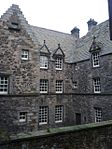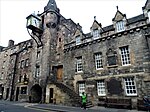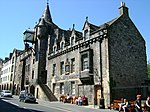Panmure House (Edinburgh)

Panmure House is a 17th-century townhouse located in Edinburgh's Canongate. It is the only surviving residence of renowned Scottish philosopher Adam Smith, who lived there between 1778 and 1790. Situated close to the Scottish Parliament, in the heart of a UNESCO World Heritage Site, the House is an important monument of Scottish intellectual history. During his time living at Panmure House, Smith continued to study and write, producing four new editions of his magnum opus The Wealth of Nations between 1778 and 1789. He was still at work on the final edition of his 1759 master work, The Theory of Moral Sentiments, when he died at Panmure House in 1790. The House is now a centre for economic and social research and debate in Smith’s name, managed by Heriot-Watt University.
Excerpt from the Wikipedia article Panmure House (Edinburgh) (License: CC BY-SA 3.0, Authors, Images).Panmure House (Edinburgh)
Lochend Close, City of Edinburgh Canongate
Geographical coordinates (GPS) Address Website Nearby Places Show on map
Geographical coordinates (GPS)
| Latitude | Longitude |
|---|---|
| N 55.95224 ° | E -3.17843 ° |
Address
Adam Smith's Panmure House
Lochend Close
EH8 8BL City of Edinburgh, Canongate
Scotland, United Kingdom
Open on Google Maps











